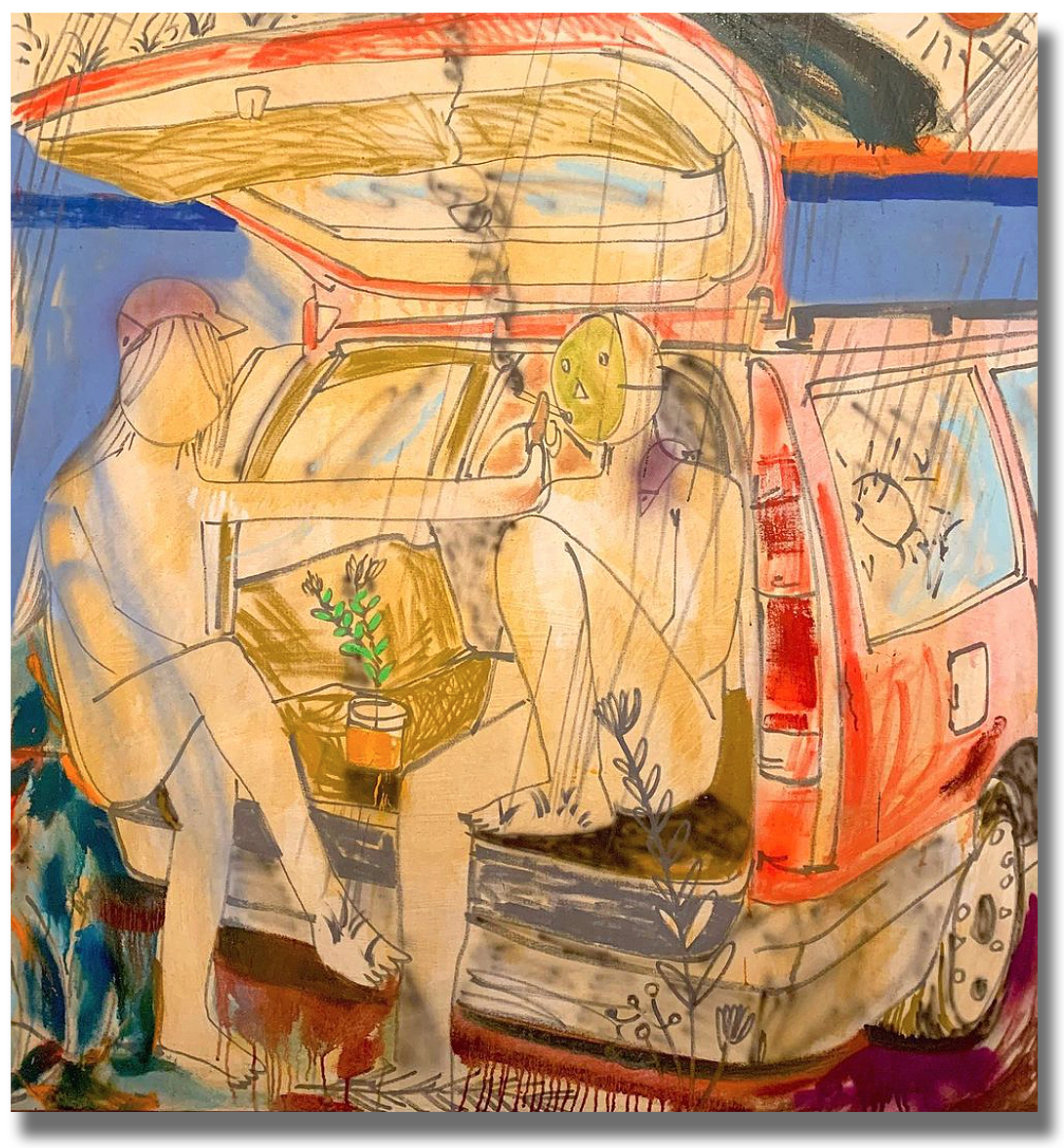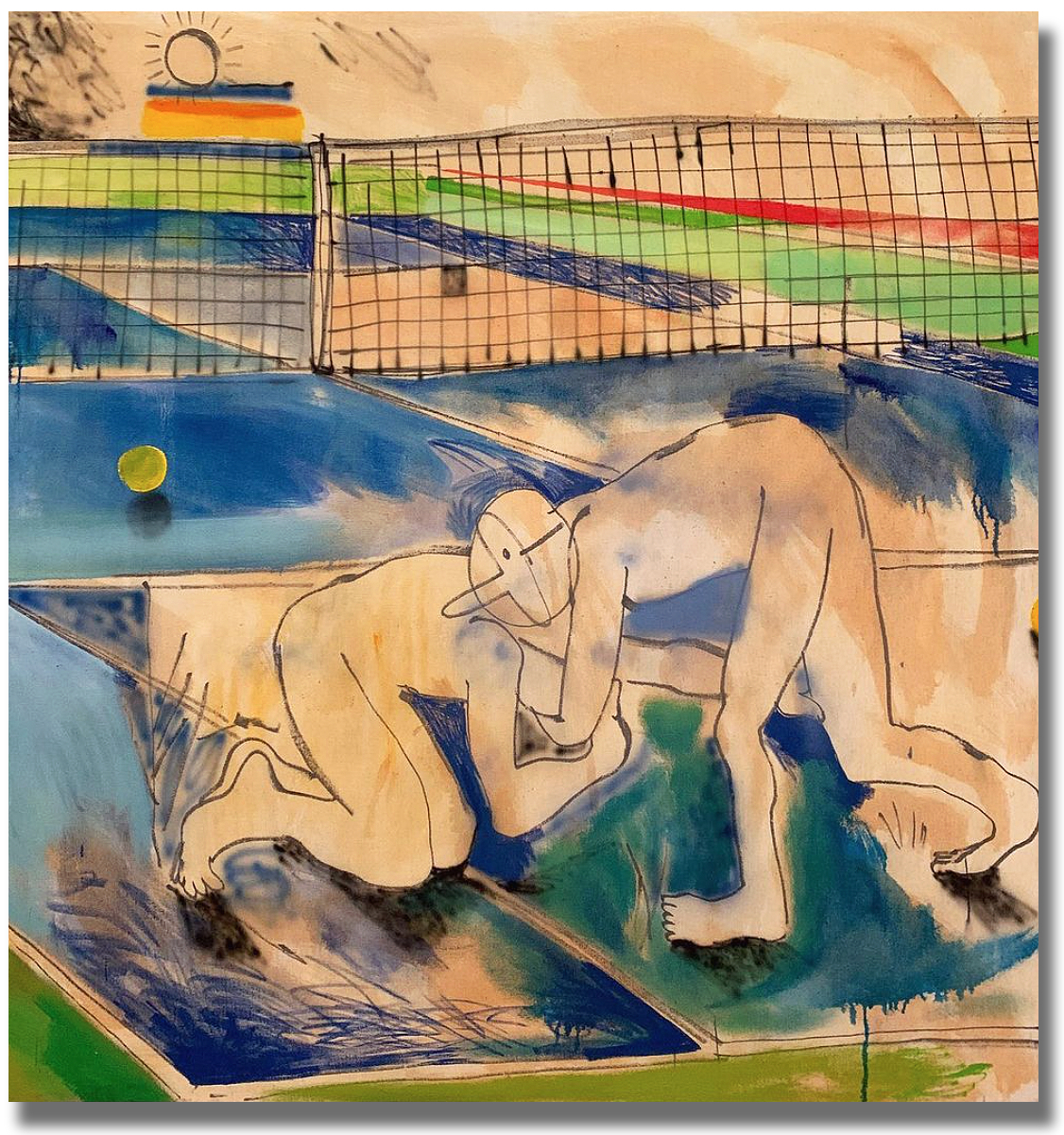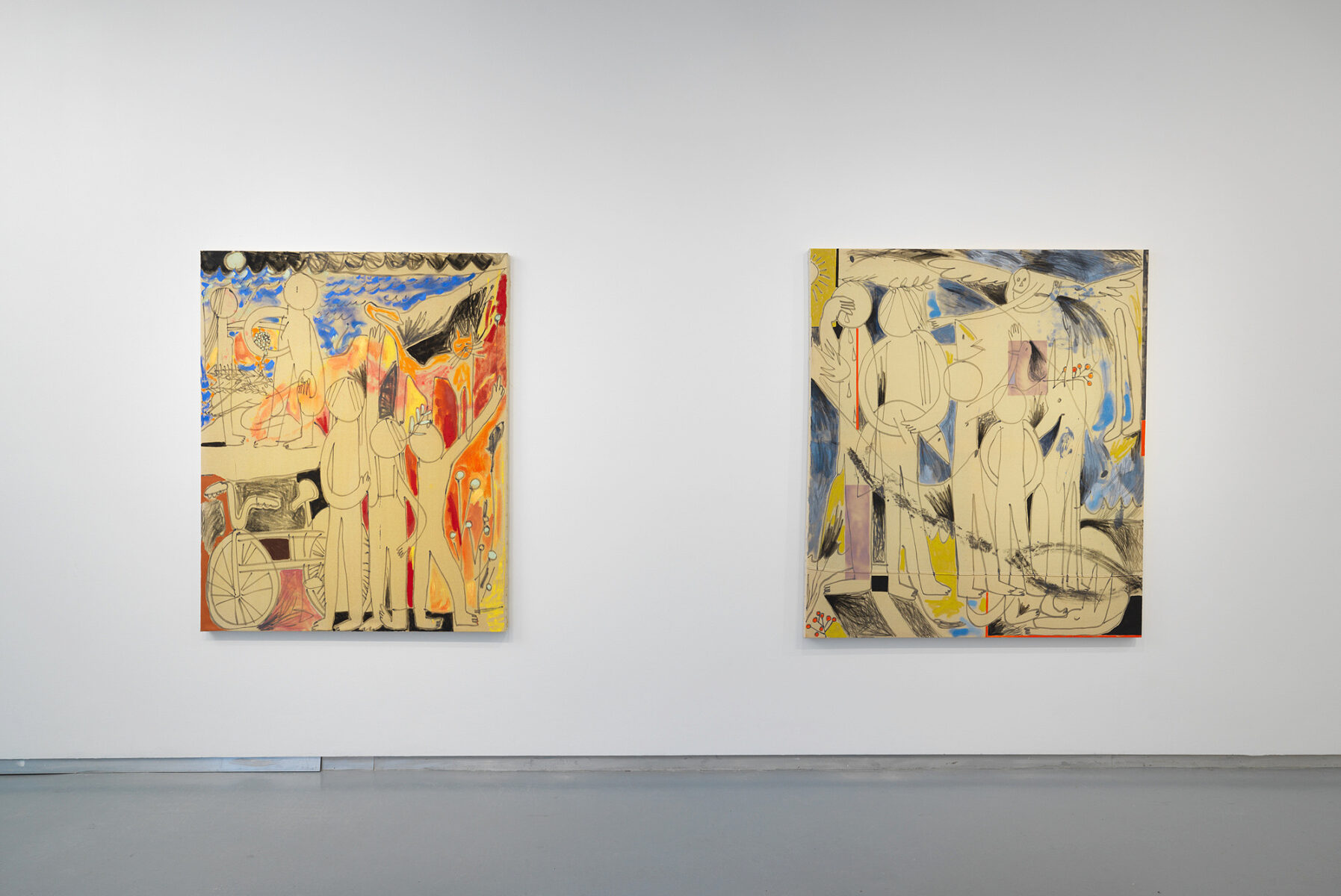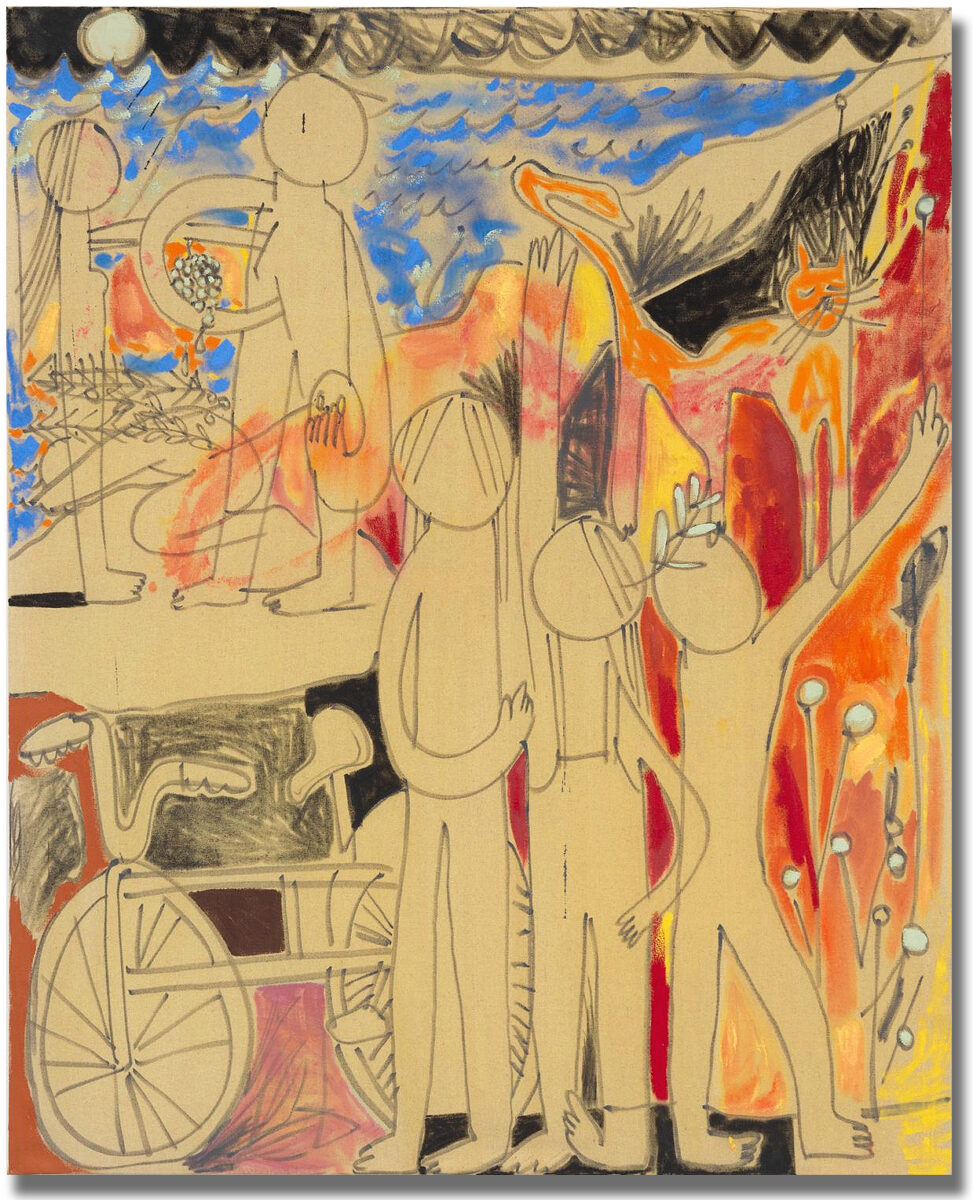
Image courtesy of Thierry Goldberg
Marco Paul Lorenzetti sits down with Erik Sommer to talk about excess, the universal idea, memories of fishing, and committing to the process.
My greatest surprise is when meaning is created without intention.
(ES) Describe your work for us.
(MPL) My work is about my life and memories. I use narrative as a structure to paint on top, off, and into. Having this structure allows me to feel uninhibited with my mark making. I think of my figures as compact-figures, comprised of many in a dreamy or surreal or maybe disjointed surrounding. I imagine my figures think they are endowed with some great importance, but really they are just silly, mostly up to no good.
Tell us a bit about your background. Where did you grow up?
I grew up in the metro Detroit area in Michigan. My father is a photographer, my mother is a graphic designer. I was one of three brothers, both of whom are pursuing careers in the arts as well. I think the great lakes of Michigan appear in my works here and there. I often reference a body of water.

Image courtesy of the artist
Where do you live and work now?
I currently live and work in a 1 bedroom apartment in Williamsburg, Brooklyn. In the summers I often work in Detroit and the Netherlands for a month.
How do you think this has influenced your work?
Living with my work is challenging at times, and sometimes I relish in it. There is no escaping the paintings. I turn works around when I’m not working on them to get a temporary visual pause. Many parts of my living situation influence my work. I try not to make too many moves a day on a piece, as the accumulation of oil paint and linseed has a heavy smell. Living with my work allows me to work 24/7 from early morning or odd times at night. It gives me the flexibility to interact with a painting when I need to or am in the right place to work. Though this confinement with the work is sometimes intense I think I have gotten a few pieces out of it.

Image courtesy of the artist
Do you remember any artists as a child that captured your attention?
First that come to mind are Dr. Seuss, Eric Carle, Shel Silverstein.
Any artists today you are looking at?
Currently probably Tamuna Sirbiladze, James Ensor, and A.R Penck.
Your colors have a washed finish which suggests a sense of impermanence. Why is this important to you?
Most of all it is about atmosphere, and adding a sense of space and breadth to the image. It is also economical, working in a way to produce the most work with a few tubes of paint. I think this reduction of material also talks about excess and trying to remove that from the work. Maybe one day hopefully I will be able to afford mountains of paint and perhaps I will get much thicker or maybe stay as is. I cannot say at this moment.
These figures remain unfinished, with a feeling of anonymity. Is this in order to capture the everyman, no-one and everyone?
Maybe leaning more toward the universal idea. It is less their ‘identity’ being unknown but more being known and related to in an odd way. There is a feeling of being encompassed in some way, regardless of who you are, in the story and narrative. Relatability is sort of an access point for painting, so I try to keep it open and in doing so I think I am able to create the strongest effect.
The settings of your work convey a sense of dreamy utopia. Do you base your settings on real places?
Usually I create a scene from my imagination. Recently though I have been pulling specific objects from my past that seem to serve as vessels, holding chunks of memories that are a signifier of a specific time in my life. I think how I come to my symbolism, the structures of the narratives I produce, is all based on something real but not necessarily alway specific. The fish for example come from fishing, and when I was younger I was unable to get a hook out of a fish that was small, killing it in the process. In some of the works the deceased fish is worn and adorned. I guess it is about taking, and waste, and our relationship to it in one small way. Every work is kind of a monument to the past or future, flattening life’s crude edges by fictionalizing it and creating these allegories. I do feel like they attempt to give something back, to communicate something.

Image courtesy of Thierry Goldberg
What is your normal studio practice like? Any routines or superstitions?
I move internally at a very high speed for better or for worse. I have always been fidgety, distracted, thinking too much, so I smoke hash often to calm down. Smoking figures are a theme in my work. It is about anxiety, taking a moment for yourself, reflection, sinking into the self, listening and looking more than talking. New York is also fixed in me- the notion that painting is athleticism, is overcoming daily weights and obstacles to create a piece. I try to run a lot, eat healthy, get rest if possible. Every part of the routine is to aid the creation of another work.

Image courtesy of Thierry Goldberg
What about your working technique? Walk us through how you start and then develop a piece.
Often I wait until the image comes to me- it appears at odd times. Then I make a painting of it. Sometimes I draw 15 iterations of an idea before committing, but I often have a general idea. I like to draw a lot too.
Are you more concerned with the process or the end result?
I know If I commit to the process the end result will come to be, like it is already there. I am certainly not trying to squeeze the painting through an expectation I have in my mind, or an imagined ideal state. I want to know that the painting is already finished but I don’t want to see it, I don’t want to know what it looks like, I just have to wait and work. Often I ruin the work and then end up bringing it back. I try to move faster than I can think, but in that leeway things are discovered and the relationship to the process deepens. My greatest surprise is when meaning is created without intention. Just a deep blind faith of the process is all you need perhaps.
What excites you the most about the current art world?
I am excited that we might have some sense of normalcy and calm come spring. I am excited to gather with other artists again; I miss having lunches and talking.
Any recent or upcoming projects?
I am really excited for a few upcoming shows in 2021. It is too early to say much right now, but I am excited for the future.
To see more of Marco Paul Lorenzetti’s work visit his website and Instagram page.
